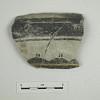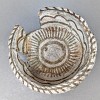
| Culture | Branch | Tradition | Ware | Type |
| Ancestral Pueblo: Greater Mogollon | Jornada Mogollon | Northern Jornada (Sierra Blanca) | Northern Jornada White Ware | Tabira Black-on-white - Polychrome |
Type Name: Tabira Black-on-white - Polychrome |
|
| Period: | 1550 A.D. - 1672 A.D. |
| Culture: | Ancestral Pueblo: Greater Mogollon |
| Branch: | Jornada Mogollon |
| Tradition: | Northern Jornada (Sierra Blanca) |
| Ware: | Northern Jornada White Ware |
First posted by C. Dean Wilson 2013
Tabira Black-on-white was defined by Toulouse (1949). This type refers to distinct decorated white wares recovered from Gran Quivira and nearby late Pueblos. Pottery exhibiting characteristics defined for this type appear to have been produced from about A.D. 1550 to 1672.
A white slip that is polished and may be crazed or pitted covers the exterior surface (Hayes and others 1981; Toulouse 1949; Vivian 1964). Polishing marks occur on undecorated surfaces. Interior surface of closed forms often shows the marks of a smoothing tool and interior surface rough and gritty. Interior surface lacks the typical brushed finish of Chupadero B/W. This type is decorated with a black mineral paint similar to that noted on Chupadero Black-o-white. Temper has been described as both a crushed andesite and biotitic felsite. Paste is light gray to gray and grainy in appearance. Surfaces are white paste to cream.
Design motifs include crosses, solid scalloped circles, feathers, conventionalized bird forms, volutes, flowers, animals, humans, plants, insects, rosettes, and arrows. The overall organization of designs has been described as a major departure of conventions noted for Chupadero Black-on-white. Designs often consisted of a single motif that was divided into four opposing but distinct panels. These are organized into bands that are framed by broad lines with a break usually occurring at some point along circumference. The very rare examples of pottery assigned to Tabira Polychrome are similar but contain the addition of thin red or yellow pigments as fill between areas decorated with black iron oxide. Ollas are the most common form although jars and pitchers are represented. Jars and ollas have short necks and out-flaring rims. Other forms occurring in low frequencies include bowls, miniature vessels, soup plates, cups, and candlestick holders.
The origins of Tabira Black-on-white have been debated with Hayes and Warren suggesting that the production of Tabira Black-on-white represented a break from Chupadero Black-on-white resulting from the migration of a new group of people from the Zuni or Hopi region (Hayes and others 1981). Wiseman (1984) has cited evidence for continuity of production between Chupadero Black-on-white and Tabira Black-on-white. A direct development out of Chupadero Black-white seems to be most likely, with many of the new elements reflecting broad stylistic influences that occurred across much of the Southwest.
References:
Hayes, Alden C., Jon N. Young, and A.H. Warren
1981 Contributions to Gran Quivira Archaeology, Gran Quivira National Monument, New Mexico. Publications in Archaeology No, 17, National Park Service Washington D.C.
Toulouse, Joseph H., Jr
1949 The Mission of Gan Gregorio de Abo. School of American Researh Series No. 13. University of New Mexico Press, Albuquerque.
Vivian, Gordon
1964 Excavations in a 17th Century Jumano Pueblo, Gran Quivira. National Park Service Archaeological Research Series, No. 8, Washington.
Wiseman, Regge N.
Chupaero and Tabira Black-on=white: Continuum or Dichotomy?. The Kiva 50(1)41-52.
Related Photos
 © New Mexico Office of Archaeological Studies, a division of the New Mexico Department of Cultural Affairs.
© New Mexico Office of Archaeological Studies, a division of the New Mexico Department of Cultural Affairs.
The Center for New Mexico Archaeology
7 Old Cochiti Road
Santa Fe, NM 87507
505-476-4404
Fax: 505-476-4448










